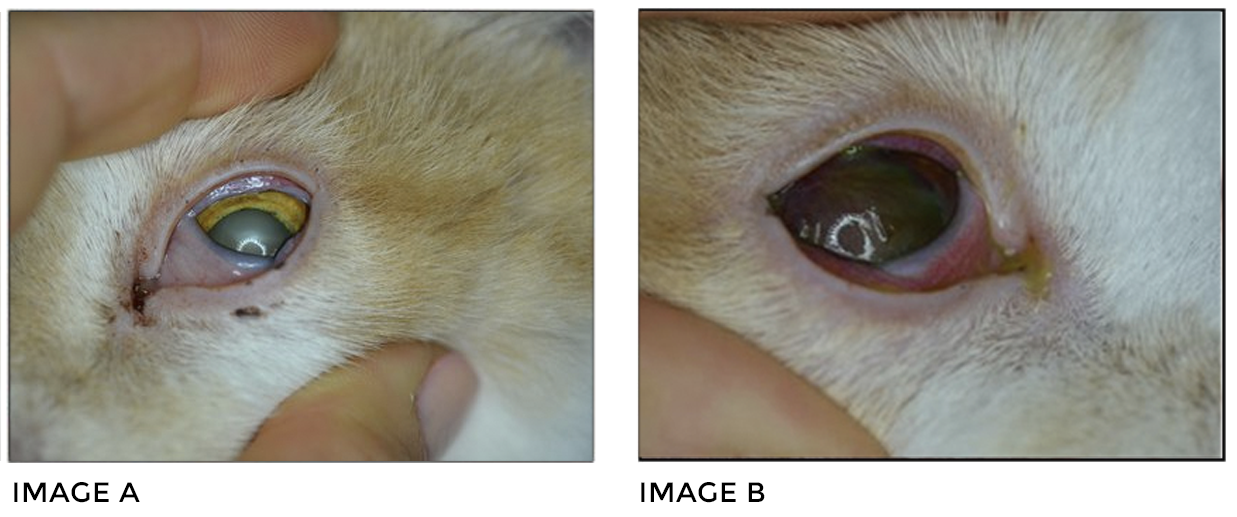Feline Herpesvirus: Ocular Manifestations
By Rachel Mathes, DVM, MS, Diplomate ACVO
Feline herpesvirus-1 (FHV-1) is a common viral agent in cats, ubiquitous in the feline population.1It is estimated that 90-95% of cats harbor the virus, usually as a latent infection. Most often this virus does not cause clinical disease in healthy cats; however, a certain percentage of cats develop recurrent or recrudescent disease.1,2Neonatal infections may cause serious ocular disease or blindness. Most often, however, if an adult cat is affected, this disease causes ocular morbidity with varied severity.3Viremia appears to be important in the initial infection, but may be of less importance in recrudescent disease.4FHV-1 is directly epitheliotoxic to conjunctival and corneal epithelial cells. Because of this, the most common ocular manifestations of FHV-1 disease are keratitis and conjunctivitis.5Feline herpesvirus is difficult to detect using serology, PCR, and VI (virus isolation), therefore, the diagnosis is usually made based on clinical suspicion of disease.4Feline herpesvirus 1 cause changes to the preocular tear film with affected cats having an increased tear film break up time (increased drying on the ocular surface) and decreased goblet cell density.6Clinical signs may vary with herpetic disease, but blepharospasm (squinting), blepharedema (eyelid swelling), conjunctival hyperemia, chemosis (conjunctival edema), variable corneal ulceration, and corneal vascularization are commonly present (figure).1Secondary signs related to chronic irritation may also be noted and include corneal sequestrae, entropion, dry eye disease, corneal perforation, and secondary bacterial infections. Treatment is aimed at supportive care including tear stimulants, tear replacers, reducing environmental and external stressors, and topical antibiotics if corneal ulcers are present. Antiviral therapy is sometimes recommended in severe cases of FHV-1 infections.7Options for antiviral medications include topical and/or systemic therapy.8Oral lysine has not been shown to improve the clinical signs of herpetic disease.9In fact, lysine has caused worsening of clinical signs in some studies.10This disease may be frustrating to treat and treatment may extend weeks, months or years. Because the virus is so common in feline populations, caution is advised in treating any cat exhibiting signs of keratitis or conjunctivitis with a topical or oral steroid as steroids have been shown to cause viral recrudescence.
 The left (A) and right (B) eye of a patient with clinical signs of herpesvirus are depicted. Eyelid swelling, conjunctival hyperemia, and chemosis are present in both eyes. This patient was also sneezing on examination, a sign consistent with active herpetic disease. Both eyes were painful, as manifested by the third eyelid elevation. The right eye has extensive corneal vascularization and corneal ulceration present. Cats presenting with active corneal and conjunctival disease should receive supportive therapy +/- antiviral medications. Topical and oral steroids should always be avoided.
The left (A) and right (B) eye of a patient with clinical signs of herpesvirus are depicted. Eyelid swelling, conjunctival hyperemia, and chemosis are present in both eyes. This patient was also sneezing on examination, a sign consistent with active herpetic disease. Both eyes were painful, as manifested by the third eyelid elevation. The right eye has extensive corneal vascularization and corneal ulceration present. Cats presenting with active corneal and conjunctival disease should receive supportive therapy +/- antiviral medications. Topical and oral steroids should always be avoided.
REFERENCES
- Gould D. Feline herpesvirus-1: ocular manifestations, diagnosis and treatment options. J Feline Med Surg. 2011; 13: 333-46.
- Zicola A, et al. Feline herpesvirus 1 and feline calicivirus infections in a heterogenous cat population of a rescue shelter. J Feline Med Surg. 2009;11;1023-7.
- Wieliczko A, et al. Feline herpesvirus 1 and Chlamydophila felis prevalence in cats with chronic conjunctivitis. Pol J Vet Sci. 2010;13:381-3.
- Westermeyer H, et al. Assessment of viremia associated with experimental primary feline herpes
- Hillstrom A, et al. Evaluation of cytologic findings in feline conjunctivitis. Vet Clin Pathol. 2012;41:283-90.
- Lim C, et al. Effects of feline herpesvirus 1 on tear film breakup time, Schirmer tear test results and conjunctival goblet cell density in experimentally infected cats. Am J Vet Res. 2009;70:394-403.
- Fontenelle J, et al. Effect of topical ophthalmic application of cidofovir on experimentally induced primary ocular feline herpesvirus-1 infection in cats. Am J Vet Res. 2008;69:189-93.
- Thomasy S, et al. Pharmacokinetics of famciclovir and penciclovir in tears following oral administration of famciclovir to cats: a pilot study. 2012;15:299-306.
- Rees T, et al. Oral supplementation with L-lysine did not prevent upper respiratory infection in a shelter population of cats. J Feline Med Surg. 2008;10:510-3.
- Drazenovich T, et al. Effects of dietary lysine supplementation on upper respiratory and ocular disease and detection of infectious organisms in cats within an animal shelter. Am J Vet Res. 2009:70:1391-400.